Top Rankings
Watertown School District ranks among the top 20% of public school district in Massachusetts for:
Category
Attribute
Diversity
Most diverse schools (Top 1%)
Student Attention
Lowest student:teacher ratio (Top 1%)
For the 2025 school year, there is 1 public middle school serving 551 students in Watertown School District. This district's average middle testing ranking is 7/10, which is in the top 50% of public middle schools in Massachusetts.
Public Middle School in Watertown School District have an average math proficiency score of 49% (versus the Massachusetts public middle school average of 38%), and reading proficiency score of 46% (versus the 42% statewide average).
Minority enrollment is 43% of the student body (majority Hispanic), which is less than the Massachusetts public middle school average of 53% (majority Hispanic).
Overview
This School District
This State (MA)
# Schools
5 Schools
526 Schools
# Students
2,717 Students
299,731 Students
# Teachers
266 Teachers
26,316 Teachers
Student : Teacher Ratio
10:1
10:1
District Rank
Watertown School District, which is ranked within the top 50% of all 393 school districts in Massachusetts (based off of combined math and reading proficiency testing data) for the 2021-2022 school year.
The school district's graduation rate of 85-89% has decreased from 90-94% over five school years.
Overall District Rank
#176 out of 397 school districts
(Top 50%)
(Top 50%)
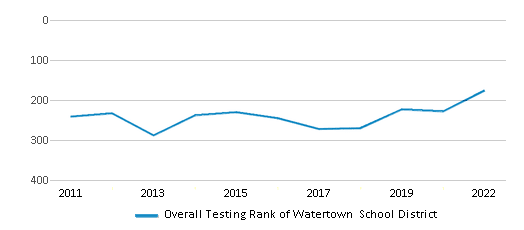
Math Test Scores (% Proficient)
46%
41%
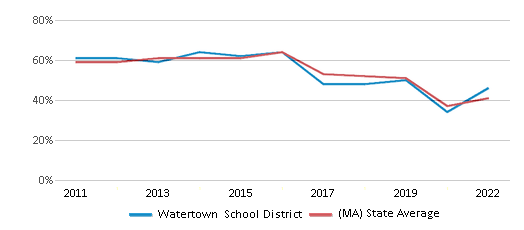
Reading/Language Arts Test Scores (% Proficient)
47%
44%
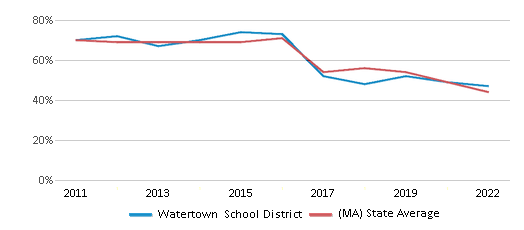
Science Test Scores (% Proficient)
42%
44%
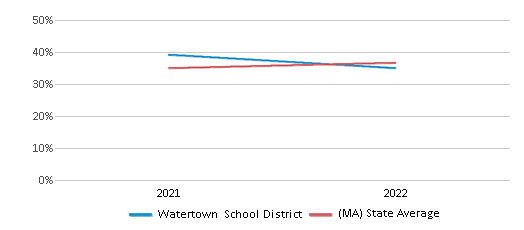
Graduation Rate
85-89%
90%

Students by Ethnicity:
Diversity Score
0.63
0.68
# American Indian Students
4 Students
816 Students
% American Indian Students
n/a
n/a
# Asian Students
220 Students
21,318 Students
% Asian Students
8%
7%
# Hispanic Students
631 Students
84,297 Students
% Hispanic Students
23%
28%
# Black Students
108 Students
37,053 Students
% Black Students
4%
12%
# White Students
1,511 Students
142,107 Students
% White Students
56%
48%
# Hawaiian Students
1 Student
291 Students
% Hawaiian Students
n/a
n/a
# Two or more races Students
234 Students
13,358 Students
% of Two or more races Students
9%
5%
Students by Grade:
# Students in PK Grade:
132
2,713
# Students in K Grade:
230
7,222
# Students in 1st Grade:
208
7,530
# Students in 2nd Grade:
232
7,944
# Students in 3rd Grade:
189
8,002
# Students in 4th Grade:
204
8,676
# Students in 5th Grade:
211
19,802
# Students in 6th Grade:
186
55,437
# Students in 7th Grade:
184
68,011
# Students in 8th Grade:
181
68,221
# Students in 9th Grade:
175
11,995
# Students in 10th Grade:
199
11,729
# Students in 11th Grade:
210
11,460
# Students in 12th Grade:
172
10,610
# Ungraded Students:
4
379
District Revenue and Spending
The revenue/student of $30,291 is higher than the state median of $23,845. The school district revenue/student has declined by 7% over four school years.
The school district's spending/student of $51,386 is higher than the state median of $24,602. The school district spending/student has declined by 7% over four school years.
Total Revenue
$82 MM
$21,850 MM
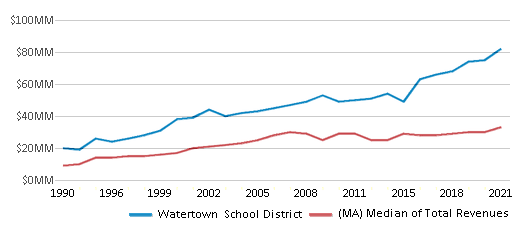
Spending
$140 MM
$22,544 MM

Revenue / Student
$30,291
$23,845
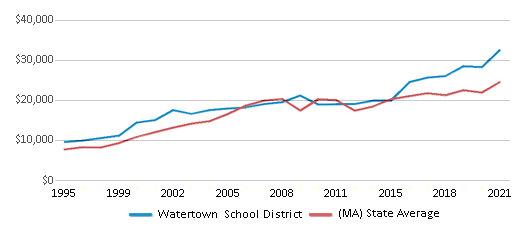
Spending / Student
$51,386
$24,602
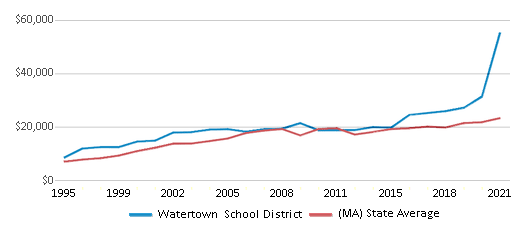
Best Watertown School District Public Middle Schools (2025)
School
(Math and Reading Proficiency)
(Math and Reading Proficiency)
Location
Grades
Students
Rank: #11.
Watertown Middle School
(Math: 49% | Reading: 46%)
Rank:
Rank:
6/
Top 50%10
68 Waverley Avenue
Watertown, MA 02472
(617) 926-7783
Watertown, MA 02472
(617) 926-7783
Grades: 6-8
| 551 students
Recent Articles

What Is A Charter School?
Explore the world of charter schools in this comprehensive guide. Learn about their history, how they operate, and the pros and cons of this educational innovation. Discover key facts about charter schools, including admission policies, demographics, and funding, as well as what to look for when considering a charter school for your child.

10 Reasons Why High School Sports Benefit Students
Discover the 10 compelling reasons why high school sports are beneficial for students. This comprehensive article explores how athletics enhance academic performance, foster personal growth, and develop crucial life skills. From improved fitness and time management to leadership development and community representation, learn why participating in high school sports can be a game-changer for students' overall success and well-being.

February 05, 2025
Understanding the U.S. Department of Education: Structure, Impact, and EvolutionWe explore how the Department of Education shapes American education, from its cabinet-level leadership to its impact on millions of students, written for general audiences seeking clarity on this vital institution.





